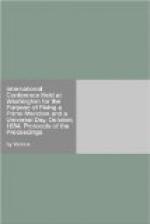The PRESIDENT. The Chair would be very glad to hear Sir WM. THOMSON’S views on this subject if it were before the Conference for discussion, but it is not.
Sir WILLIAM THOMSON. I beg pardon for having mentioned it.
I would repeat that the adoption of the meridian of Greenwich is one of convenience. The difference of other meridians from it is readily ascertained, and therefore it seems to me that the minimum of trouble will be entailed on the world by the general adoption of the meridian of Greenwich. This would require the minimum of change, and, furthermore, the changes which would be necessary are already wholly ascertained.
I would inquire of the Chair whether it would be in order for me to allude to the resolutions number 2 and 3, which have been read?
The PRESIDENT. I think that we must confine ourselves to the subject immediately under discussion—the adoption of a prime meridian.
Sir WILLIAM THOMSON. Then I have only to thank you and the Delegates for allowing me to speak, and to express my very strong approbation of the resolution that has been proposed.
Sir F. J. O. EVANS, Delegate of Great Britain, then made the following remarks:
In view of the interesting information furnished to the Congress by M. JANSSEN on the hydrographic labors of France, past and present, and of the results as represented by the number of Government charts; it has appeared to myself—as having held the office of hydrographer to the Admiralty of Great Britain for many years—in which opinion I am supported by my colleagues, that I should place at the disposal of the Congress certain statistical facts bearing on the great interests of navigation and commerce, as illustrated by the number of marine charts, of sailing directions, and of nautical almanacs annually produced under the authority of the British Government, and of their distribution.
I would wish to disclaim any comparison in this respect with the labors of other countries. From personal knowledge I am aware that all nations—with only one or two exceptions—are, and especially so in the last few years, diligent in the development of hydrography, and that a cordial interchange of the results unfettered by any conditions is steadily being pursued.
With this preface I would lay before you the following statements, observing that the shores of the whole navigable parts of the globe are embraced in the series of Admiralty charts referred to:
The number of copper chart plates in constant use is between 2,850 and 2,900. This number keeps up steadily. About 60 new plates are added every year.
Average number of copper plates annually receiving correction amount to 2,700.
Total number of charts annually printed for the daily use of the ships of Her Majesty’s fleet in commission, and for sale to the general public, has for some years ranged between 180,000 and 230,000.




